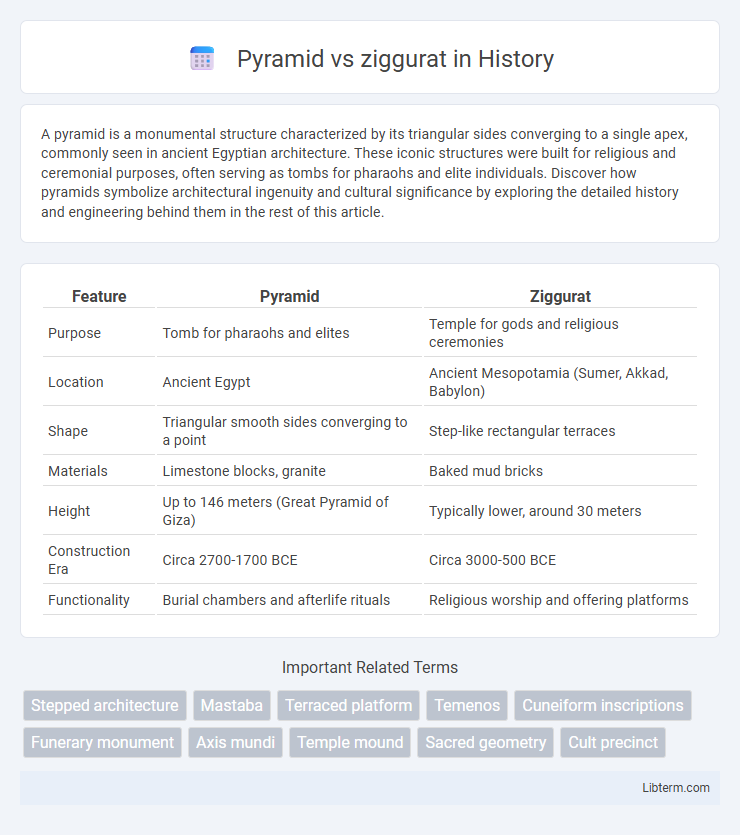A pyramid is a monumental structure characterized by its triangular sides converging to a single apex, commonly seen in ancient Egyptian architecture. These iconic structures were built for religious and ceremonial purposes, often serving as tombs for pharaohs and elite individuals. Discover how pyramids symbolize architectural ingenuity and cultural significance by exploring the detailed history and engineering behind them in the rest of this article.
Table of Comparison
| Feature | Pyramid | Ziggurat |
|---|---|---|
| Purpose | Tomb for pharaohs and elites | Temple for gods and religious ceremonies |
| Location | Ancient Egypt | Ancient Mesopotamia (Sumer, Akkad, Babylon) |
| Shape | Triangular smooth sides converging to a point | Step-like rectangular terraces |
| Materials | Limestone blocks, granite | Baked mud bricks |
| Height | Up to 146 meters (Great Pyramid of Giza) | Typically lower, around 30 meters |
| Construction Era | Circa 2700-1700 BCE | Circa 3000-500 BCE |
| Functionality | Burial chambers and afterlife rituals | Religious worship and offering platforms |
Introduction: Understanding Pyramids and Ziggurats
Pyramids and ziggurats are ancient monumental structures with distinct architectural and cultural differences, primarily found in Egyptian and Mesopotamian civilizations respectively. Pyramids, characterized by their smooth, angled sides, served as royal tombs designed to facilitate the pharaohs' journey to the afterlife. Ziggurats feature terraced steps and flat tops, functioning as temples dedicated to gods, reflecting the religious practices of societies like the Sumerians and Babylonians.
Historical Origins and Civilizations
Pyramids originated primarily in ancient Egypt as monumental tomb structures for pharaohs, dating back to around 2700 BCE during the Old Kingdom period. Ziggurats were built by ancient Mesopotamian civilizations such as the Sumerians, Akkadians, and Babylonians between 3000 and 600 BCE as terraced temple platforms dedicated to their deities. Both structures reflect the religious and cultural priorities of their respective societies, with pyramids emphasizing the afterlife and ziggurats serving as intermediaries between the earth and the heavens.
Architectural Design and Structure
Pyramids feature smooth, angled sides that converge to a single point, emphasizing a geometric precision and alignment with astronomical events, primarily built as tombs in ancient Egypt. Ziggurats are terraced, multi-level platforms with a flat top, constructed from mud-brick and used as temples in Mesopotamian architecture, facilitating religious ceremonies on elevated surfaces. The pyramids' solid stone core contrasts with the ziggurats' layered, stepped design, reflecting differing cultural functions and structural engineering techniques.
Purpose and Functionality
Pyramids, primarily built as monumental tombs in ancient Egypt, served as burial sites for pharaohs and were designed to ensure a passage to the afterlife. Ziggurats, constructed in Mesopotamia, functioned as terraced temple platforms used for religious rituals and a bridge between earth and the divine. While pyramids emphasized eternal preservation, ziggurats prioritized religious worship and community gathering.
Religious and Cultural Significance
Pyramids served as monumental tombs in ancient Egyptian culture, emphasizing the pharaoh's divine status and the journey to the afterlife through intricate burial rites and religious symbolism. Ziggurats, central to Mesopotamian city-states like Ur and Babylon, functioned as elevated temples dedicated to specific gods, symbolizing the connection between heaven and earth and facilitating ritual ceremonies. Both structures embodied the spiritual beliefs and cosmology of their societies, reflecting differing religious practices surrounding death and divine worship.
Construction Techniques and Materials
Pyramids, primarily constructed from large limestone and granite blocks, feature smooth, angled sides achieved through precise stone cutting and layering techniques evident in Egyptian structures like the Great Pyramid of Giza. Ziggurats, built by ancient Mesopotamians, utilize sun-dried mud bricks layered in terraces, often reinforced with baked bricks on the exterior for weather resistance and a stepped design that served religious functions. The contrasting materials and construction methods reflect differences in climate, available resources, and cultural purposes between the two architectural forms.
Geographic Locations and Distribution
Pyramids are predominantly found in Egypt, particularly along the Nile River, with notable examples such as the Great Pyramid of Giza, while ziggurats are primarily located in ancient Mesopotamia, especially in present-day Iraq and Iran. Egyptian pyramids served as royal tombs and are characterized by smooth, angled sides, contrasting with the stepped, terrace-like structure of Mesopotamian ziggurats, which functioned as temples. This geographical distribution reflects distinct cultural and religious practices in North Africa and the Ancient Near East.
Key Differences Between Pyramids and Ziggurats
Pyramids are smooth-sided, triangular structures primarily built as tombs in ancient Egypt, while ziggurats are terraced, step-like temples constructed by Mesopotamian civilizations for religious purposes. Pyramids utilize limestone and granite blocks to create a pointed shape symbolizing a stairway to the afterlife, whereas ziggurats consist of mud bricks featuring multiple staircases leading to a shrine at the top. The functional distinction lies in pyramids serving burial and memorial roles, compared to ziggurats acting as elevated platforms for worship and rituals.
Famous Examples Around the World
The Great Pyramid of Giza in Egypt stands as the most iconic pyramid, known for its precise geometric design and massive scale. In contrast, the Ziggurat of Ur in modern-day Iraq exemplifies ancient Mesopotamian ziggurats, characterized by their tiered, rectangular platforms and religious function. Both structures highlight distinct architectural styles and cultural purposes within ancient civilizations.
Legacy and Influence on Modern Architecture
Pyramids, exemplified by the Egyptian Great Pyramid, and Mesopotamian ziggurats both influenced monumental architecture through their massive scale and symbolic design, shaping cultural identity and religious expression in ancient civilizations. The stepped design of ziggurats contributed to the development of tiered structures and terraced buildings in modern architecture, while pyramids inspired the use of geometric precision and monumental solidity in contemporary designs. Their legacy persists in the integration of symbolic form and structural engineering in public buildings and memorials worldwide.
Pyramid Infographic

 libterm.com
libterm.com